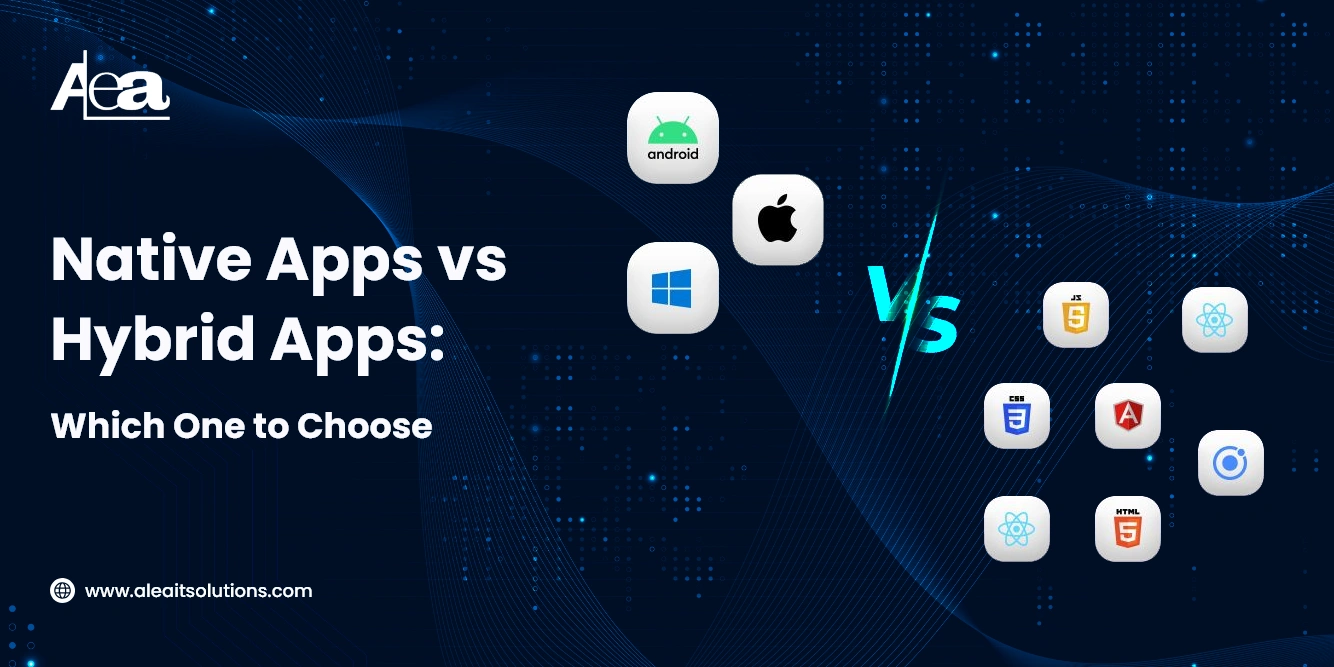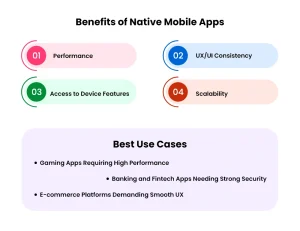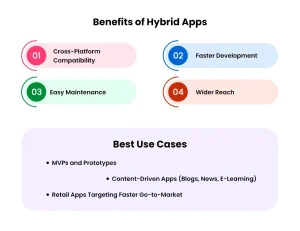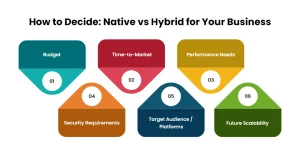Mobile apps have quickly become the heartbeat of customer engagement and business growth. They’re no longer just add-ons but essential tools in industries like retail, healthcare, banking, and entertainment. For most people, apps are now the first and most frequent way they connect with a brand.
With billions of smartphone users worldwide and mobile-first strategies shaping industries, building the right mobile app is no longer a luxury it’s a necessity. The numbers speak for themselves.
According to Statista, global mobile app revenues are expected to exceed $613 billion by 2025, proving that investing in mobile app development is one of the most strategic moves for businesses today.
But the critical question remains: which approach should you choose Native or Hybrid app development?
Native app development is performed for a single platform (iOS or Android), offering superior performance, seamless user experiences, and deeper integration with device features.
Hybrid app development, on the other hand, use a single codebase to run across multiple platforms, making them faster to develop, more cost-effective, and easier to maintain.
Each approach has unique strengths and trade-offs related to user experience (UX), performance, security, development cost, and scalability. The decision you make will directly influence how your customers perceive your brand and how well your app supports your long-term growth strategy.
In this blog, we’ll provide a detailed breakdown of Native vs Hybrid Mobile App Development exploring their differences, advantages, limitations, and the tools used to build them. By the end, you’ll have a clear roadmap to decide which app development approach best suits your business goals.
Market Statistics Beyond Revenue
Mobile applications dominate the digital landscape, and choosing between native and hybrid development affects performance, ROI, and user retention. According to recent mobile app statistics Google Play has over 5.5 million apps and the Apple App Store around 3.5 million, reflecting high demand.
Users spend 4–5 hours daily on apps, according to App Annie. Android holds 72% of global market share, iOS 27%, making cross-platform reach key. Global downloads exceeded 250 billion in 2024, but only 32% of users stay after 90 days, showing native apps often retain better.
Frameworks like Flutter and React Native have grown 50% in adoption, highlighting hybrid’s role in faster launch. Businesses must align development strategy with these trends to maximize ROI.
Difference Between Native and Hybrid App
Native Mobile App Development
Native app development refers to building applications specifically for a single platform, such as iOS or Android, using platform-specific programming languages. iOS apps are developed with Swift or Objective-C, while Android apps are built using Kotlin or Java.
Native apps interact directly with the device’s operating system, allowing full access to hardware features like the camera, GPS, sensors, microphone, and push notifications. This results in high performance, fast load times, and smooth animations, providing a superior user experience.
Native apps are also highly secure and reliable, making them ideal for applications that handle sensitive data, such as banking or enterprise apps. Following platform-specific design guidelines ensures intuitive navigation and familiarity for users.
Typical use cases include high-performance gaming apps, complex enterprise solutions, banking apps, and augmented or virtual reality applications.
Popular examples of native apps include Instagram, WhatsApp, and Google Maps, all of which rely heavily on platform-specific capabilities and advanced performance requirements.
While native development requires separate codebases for iOS and Android, which can increase development time and the overall mobile app development cost, the benefits in performance, security, and user experience make it the preferred choice for mission-critical applications.
Native Mobile Apps for iOS & Android
Native apps are mobile applications built exclusively for a specific operating system either iOS or Android. Unlike cross-platform solutions, native apps are developed using platform-specific programming languages and tools.
For iOS, developers typically use Swift or Objective-C within Xcode, Apple’s official development environment. For Android, the most common languages are Java and Kotlin, supported by Android Studio.
Because they are tailored for a single platform, native apps are optimized to fully leverage the device’s operating system, hardware, and built-in features. This results in exceptional performance, faster load times, and seamless integration with functionalities like GPS, camera, push notifications, and biometrics.
Moreover, native apps strictly follow platform design guidelines such as Apple’s Human Interface Guidelines or Google’s Material Design which ensures a consistent and intuitive user experience that feels natural to the end user.
For businesses aiming to deliver highly engaging, secure, and scalable applications, native development remains the gold standard. Whether it’s a feature-rich e-commerce platform, a financial app with advanced security, or a high-performance gaming solution, native apps excel in delivering reliability, responsiveness, and superior UX.
Benefits of Native Mobile Apps
1. Performance
Native apps are directly compiled into machine code, which makes them faster, smoother, and highly reliable.
They take full advantage of the platform’s processing power, resulting in shorter load times, responsive interfaces, and better overall efficiency, even under heavy usage.
2.UX/UI Consistency
Designed with platform-specific guidelines like Apple’s Human Interface Guidelines or Google’s Material Design, native apps provide a familiar look and feel for users.
This ensures consistent navigation, smooth animations, and intuitive interactions, which directly enhance customer satisfaction and retention.
3. Access to Device Features
Native development allows apps to tap into the full range of hardware and OS-level functionalities such as GPS, camera, microphone, push notifications, NFC, and biometric authentication. This leads to more feature-rich and innovative apps compared to other approaches.
4. Scalability
Native apps are built with robust architecture and platform-native APIs, making them easier to scale as your business grows.
Whether it’s adding new features, integrating with third-party services, or expanding to enterprise-level solutions, native apps provide a future-ready foundation.
Best Use Cases of Native Apps
1. Gaming Apps Requiring High Performance
Games demand fast rendering, smooth animations, and real-time responsiveness to deliver an immersive experience.
Native development ensures that games can fully utilize the device’s GPU, CPU, and memory, which is critical for 3D graphics, augmented reality (AR), or high-definition mobile gaming.
2. Banking and Fintech Apps Needing Strong Security
Financial applications handle sensitive data and transactions, making security a top priority. Native apps can leverage built-in security features like biometric authentication, data encryption, and secure storage.
This makes them ideal for banking, payment gateways, stock trading, and insurance apps that cannot compromise on reliability or compliance.
3. E-commerce Platforms Demanding Smooth UX
In e-commerce, even a small delay in performance can result in cart abandonment and lost revenue. Native apps provide faster load times, intuitive navigation, and seamless checkout processes, ensuring a frictionless shopping experience.
They can also integrate with device features like push notifications, location services, and digital wallets to boost engagement and sales.
Hybrid Web App Development
Hybrid app development combines web technologies such as HTML, CSS, and JavaScript with native containers, enabling the app to run on multiple platforms simultaneously.
Frameworks like React Native, Flutter, and Ionic allow developers to maintain a single codebase that works on both Android and iOS, reducing development costs and simplifying maintenance.
Hybrid apps are especially useful for businesses and startups that want to launch a product quickly or test an idea through a Minimum Viable Product (MVP). These apps provide a consistent user experience across devices and allow updates or bug fixes to be deployed simultaneously across all platforms.
Hybrid apps are ideal for content-heavy applications, multi-platform business apps, and projects requiring moderate device integration. Popular examples include Uber Eats, Gmail App, and Twitter Lite, demonstrating how hybrid apps can achieve broad reach while remaining functional and efficient.
Although hybrid apps may not match native apps in performance or advanced hardware integration, they offer cost-effectiveness, faster deployment, and flexibility, making them a practical solution for many businesses.
Web-Based Hybrid Apps
Hybrid apps are mobile applications developed using standard web technologies such as HTML, CSS, and JavaScript, which are then encapsulated within a native container. This unique approach allows them to run seamlessly across multiple platforms such as iOS and Android while sharing a single codebase.
Instead of building separate apps for each operating system, businesses can develop once and deploy everywhere, significantly reducing time and cost. To achieve this, hybrid apps rely on popular cross-platform frameworks like React Native, Flutter, Ionic, and Xamarin.
These mobile app frameworks bridge the gap between web code and native functionality, enabling developers to access certain device features like the camera, notifications, or geolocation through plugins and APIs.
While hybrid apps may not always match the raw performance and deep integration of native apps, they excel at offering faster development cycles, easier maintenance, and broader reach.
For businesses that want to validate an idea quickly, launch a minimum viable product (MVP), or target a wide audience without heavy upfront investment, hybrid development is often the preferred choice.
Benefits of Hybrid Apps
1. Cross-Platform Compatibility
Hybrid apps use a single codebase to run on both iOS and Android platforms. This significantly reduces development time and costs, as businesses don’t need to build and maintain separate apps for each operating system.
2. Faster Development:
By leveraging web technologies and cross-platform frameworks, hybrid apps can be developed and deployed quickly, making them ideal for startups or businesses with tight budgets
This approach allows teams to launch products faster and validate ideas without extensive investment.
3. Easy Maintenance
Since hybrid apps share one codebase, updates, bug fixes, and new features can be rolled out simultaneously across platforms.
This simplifies ongoing maintenance and ensures all users have a consistent experience regardless of device.
4. Wider Reach
With the ability to deploy on both the App Store and Google Play Store at the same time, hybrid apps can reach a broader audience more efficiently.
This is particularly beneficial for businesses looking to maximize visibility and engagement without duplicating development efforts.
Read Also: How to Develop a Billing App
Best Use Cases of Hybrid Apps
1. MVPs and Prototypes
Hybrid apps are ideal for Minimum Viable Products (MVPs) and prototypes because they allow startups and businesses to quickly test ideas without investing in separate native apps for iOS and Android.
This approach helps validate concepts, gather user feedback, and iterate efficiently before committing to a full-scale launch.
2. Content-Driven Apps (Blogs, News, E-Learning)
Apps focused primarily on delivering content rather than complex functionalities benefit from hybrid development. News platforms, blogs, and e-learning apps can leverage shared codebases and cross-platform frameworks to provide consistent user experiences across devices while minimizing development and maintenance costs.
3. Retail Apps Targeting Faster Go-to-Market
For retail businesses aiming to capture market opportunities quickly, hybrid apps offer the advantage of rapid deployment across multiple platforms.
These apps can integrate essential features like product catalogs, shopping carts, and push notifications, enabling businesses to engage customers faster and scale quickly.
Differences Between Native and Hybrid Apps
| Feature | Native Apps | Hybrid Apps |
| Performance | High speed, smooth UX | Slightly slower, depends on framework |
| Cost | Higher (separate development for iOS & Android) | Lower (single codebase) |
| Time-to-Market | Longer | Faster |
| Maintenance | Requires platform-specific updates | Easier, one update for all |
| Device Features | Full access | Limited access |
| User Experience | Seamless and consistent | Can feel less native |
Development Tools and Frameworks
Native App Tools
1, iOS Development
For building iOS apps, developers primarily use Xcode, Apple’s official Integrated Development Environment (IDE). Xcode provides a complete toolkit with features like an advanced code editor, debugging tools, interface builder, and device simulators.
Apps are commonly written in Swift, Apple’s modern, fast, and safe programming language, or Objective-C, its predecessor that still powers many legacy applications. Swift has become the preferred choice due to its cleaner syntax, performance optimization, and seamless integration with Apple’s frameworks.
2. Android Development
On the Android side, the go-to tool is Android Studio, Google’s official IDE for Android development. It comes equipped with a powerful code editor, Gradle-based build system, real-time profilers, and an emulator for testing across multiple device configurations.
Developers typically use Kotlin, Google’s recommended language for Android, known for its concise and expressive syntax, or Java, which has long been the backbone of Android development. Kotlin’s interoperability with Java and its modern features make it increasingly popular for new projects.
3. Strong Backing and Updates
Both Apple and Google continuously enhance these tools with new features, improved performance, and security updates.
This official support ensures developers can leverage the latest platform capabilities, APIs, and design guidelines, resulting in apps that run smoothly, look native, and remain future-proof.
Read Also: How to Choose the Right Tech Stack for Your Mobile App
Hybrid App Frameworks
Hybrid app frameworks allow developers to build cross-platform applications using a single codebase, significantly reducing development time and cost. Here are some of the most popular frameworks:
1. React Native
Developed by Meta, React Native is one of the most widely adopted frameworks for cross-platform app development. It allows developers to write components in JavaScript, which are then rendered as native widgets.
React Native provides excellent performance, strong community support, and a rich ecosystem of libraries, making it suitable for apps that require both speed and scalability.
2. Flutter
Google’s UI toolkit, Flutter, uses the Dart programming language and enables developers to create beautiful, high-performance apps for iOS and Android from a single codebase.
Flutter’s hot reload feature accelerates development, and its customizable widgets allow for a native-like experience across platforms, making it ideal for both startups and enterprise applications.
3. Ionic
Ionic is a lightweight framework that leverages HTML, CSS, and JavaScript to build hybrid apps. It is best suited for content-driven applications such as blogs, news apps, and e-learning platforms.
Ionic emphasizes ease of development, flexibility, and rapid prototyping, making it a favorite for small to medium-scale projects.
4. Xamarin
Backed by Microsoft, Xamarin allows developers to build enterprise-grade cross-platform apps using C# and .NET.
It offers deep integration with native APIs, strong performance, and support for large-scale enterprise solutions, making it a reliable choice for business-critical applications.
Each framework has its strengths, ideal use cases, and trade-offs, and choosing the right one depends on your app’s requirements, target audience, and development resources.
Read Also: Best Language to Develop a Mobile App
Real-World Examples of Native vs Hybrid Apps
Understanding how popular apps are built can help businesses make an informed choice between native and hybrid development. Here’s a look at real-world examples:
Native Apps
Native apps are designed for a single platform and optimized for performance, security, and seamless user experience. Some well-known examples include:
- Instagram: Built natively to handle heavy image and video processing, providing smooth animations and fast performance.
- Snapchat: Relies on native development for real-time filters, AR effects, and high-speed camera integration.
- Uber: Uses native features for GPS navigation, ride matching, and push notifications, ensuring reliability and responsiveness.
Hybrid Apps
Hybrid apps leverage a single codebase for multiple platforms, offering faster development and wider reach. Examples include:
- Airbnb (earlier versions): Used hybrid frameworks to speed up deployment across iOS and Android while maintaining a consistent UX.
- Gmail Mobile App (web-based features): Combines web technologies with native containers to deliver cross-platform access efficiently.
- Alibaba: Uses hybrid techniques for faster updates, broader platform support, and scalability for its e-commerce operations.
Native apps are preferred for performance-intensive and security-sensitive applications, while hybrid apps excel in rapid deployment, cost efficiency, and cross-platform reach. Studying these examples provides practical insight into which approach aligns with your business goals.
Future Trends and Predictions in Mobile App Development
The landscape of mobile app development is evolving rapidly, and choosing the right approach native or hybrid requires an understanding of emerging trends and future technologies.
1. Growing Adoption of Cross-Platform Frameworks
Frameworks like Flutter and React Native continue to gain traction, with Flutter seeing over 50% adoption growth among developers in recent years. Hybrid development is becoming increasingly capable of delivering near-native performance, making it an attractive choice for startups and enterprises seeking faster development cycles.
2. AI-Powered Mobile Apps
Artificial Intelligence and Machine Learning integration is set to redefine mobile experiences. Features such as personalized recommendations, intelligent chatbots, predictive analytics, and voice assistants will be standard. Both native and hybrid apps will need to leverage AI, but native apps may handle complex AI computations more efficiently due to direct access to device hardware.
3. 5G Connectivity Driving New Experiences
The global rollout of 5G networks will enable ultra-fast data transfer, low latency, and richer mobile experiences. Native apps, particularly in gaming, AR/VR, and streaming, will benefit from leveraging these high-speed capabilities. Hybrid apps can also capitalize on 5G for content-heavy applications but may need optimization for real-time performance.
4. Progressive Web Apps (PWAs) as Competitors
PWAs are bridging the gap between websites and mobile apps, offering offline capabilities, push notifications, and app-like experiences without requiring installation. Businesses may increasingly evaluate PWAs alongside hybrid apps for fast deployment and broad reach.
5. Focus on Enhanced User Experience and Security
Future mobile apps will prioritize UX personalization, intuitive navigation, and robust security. Native apps are likely to continue leading in performance-intensive applications, while hybrid apps evolve to deliver smoother UX and secure experiences through improved frameworks and APIs.
6. IoT and Wearable Device Integration
With the rise of smart devices, apps need seamless integration with IoT ecosystems. Native apps are generally better positioned to interact with hardware efficiently, but hybrid frameworks are catching up with plugins and API support for connected devices.
Prediction: By 2030, hybrid apps will dominate rapid-development and content-driven markets, while native apps will remain the preferred choice for high-performance, security-sensitive, and graphics-intensive applications. Businesses that strategically balance the two approaches will gain the most competitive advantage.
App development firms provide professional teams to build apps across industries and platforms. They handle ideation, design, coding, and support, ensuring full-cycle development.
These firms bring expertise, tools, and best practices to deliver secure, scalable, and user-friendly applications that help businesses innovate, compete, and succeed in today’s mobile-driven market.
Read Also: Types of Mobile Apps
Which one to Choose: Native vs Hybrid for Your Business
Choosing between native and hybrid app development is a strategic decision that impacts cost, performance, user experience, and long-term scalability. If you’re exploring mobile app ideas, here’s a detailed checklist to guide your decision:
1. Budget
- Native Apps: Developing separate apps for iOS and Android increases initial costs, as you need two dedicated development teams or skill sets. Maintenance costs are also higher because updates must be applied individually for each platform.
- Hybrid Apps: With a single codebase for multiple platforms, development and maintenance costs are significantly reduced. This makes hybrid apps an ideal choice for startups or businesses with limited budgets who want to reach a broad audience efficiently.
2. Time-to-Market
- Native Apps: Developing platform-specific apps takes longer, particularly if feature complexity is high. This approach is better suited for businesses that prioritize quality, performance, and security over speed.
- Hybrid Apps: Hybrid development allows faster deployment across iOS and Android simultaneously. For businesses aiming to launch an MVP, test market demand, or respond quickly to trends, hybrid apps offer a quicker go-to-market solution.
3. Performance Needs
- Native Apps: For apps that demand high performance, such as games, AR/VR experiences, or apps with complex animations, native development ensures smooth rendering, faster processing, and better responsiveness.
- Hybrid Apps: While hybrid frameworks like Flutter or React Native have significantly improved performance, they may struggle with highly resource-intensive tasks. Hybrid apps work best for content-driven, less complex, or data-light applications.
4. Security Requirements
- Native Apps: Apps handling sensitive data such as banking, healthcare, or enterprise applications benefit from native development due to direct access to platform-level security features like encryption, secure storage, and biometric authentication.
- Hybrid Apps: Security can still be implemented in hybrid apps, but it often relies on third-party plugins and cross-platform frameworks, which may introduce vulnerabilities if not carefully managed. Businesses with strict compliance requirements should lean toward native development.
5. Target Audience / Platforms
- Native Apps: Allow deep customization to match platform-specific design guidelines, ensuring a familiar, intuitive user experience. This is crucial for apps where brand perception and polished UX are key.
- Hybrid Apps: Ensure wider reach across both iOS and Android platforms with a single codebase. For businesses aiming to maximize visibility and engagement without duplicating development efforts, hybrid apps are highly effective.
6. Future Scalability
- Native Apps: Offer robust architecture and platform-native APIs, making it easier to scale and integrate advanced features as your business grows. Apps that plan for expansion, heavy data processing, or enterprise-level integrations will benefit from native development.
- Hybrid Apps: Easier to maintain and update due to a shared codebase, but may face limitations when scaling complex, high-performance features. Businesses should carefully evaluate long-term growth plans before choosing hybrid for mission-critical applications.
The choice between native and hybrid depends on balancing budget, speed, performance, security, audience reach, and scalability.
Businesses that prioritize high-performance, security-sensitive, and feature-rich applications should opt for native apps. Conversely, hybrid apps are ideal for cost-effective, cross-platform solutions, rapid launches, and content-focused applications.
An app development company specializes in building customized mobile and web applications tailored to specific business needs. These companies provide end-to-end solutions including strategy, design, development, and support.
Partnering with a professional app development company ensures high-quality apps, seamless user experiences, and innovative digital solutions that drive business growth.
Conclusion – What to Choose?
The decision between native and hybrid app development ultimately depends on your business goals, budget, timeline, and long-term strategy. Both approaches offer unique advantages, and understanding their differences is key to building an app that aligns with your objectives.
Choose Native Apps if your priority is high performance, top-notch security, and a seamless user experience (UX). Native apps are ideal for applications that demand advanced functionality, intensive graphics, or handle sensitive data, such as gaming, fintech, or large-scale e-commerce platforms.
Choose Hybrid Apps if your focus is faster time-to-market, cost-effectiveness, and reaching multiple platforms simultaneously. Hybrid apps are particularly suitable for startups, MVPs, content-driven applications, or retail apps aiming to quickly engage a broad audience without heavy upfront investment.
A mobile app development company creates apps for iOS, Android, and cross-platform users. They combine innovation, technology, and design to deliver scalable solutions.
Whether for startups or enterprises, these companies help businesses enhance customer engagement, improve efficiency, and stay ahead in the competitive digital landscape through powerful, user-friendly applications.
At Alea, we specialize in both native and hybrid mobile app development, offering tailored solutions that match your business strategy, scalability needs, and ROI expectations.
Whether you are a startup looking to validate an idea or an enterprise seeking robust, high-performance applications, our team provides end-to-end guidance, expert development, and post-launch support to ensure your app stands out in the market.
Partner with Alea to turn your app vision into reality, leveraging the right technology approach to drive growth, engagement, and long-term success.
FAQs: Native vs Hybrid Mobile App Development
1. What is the main difference between native and hybrid apps?
Native apps are built specifically for one platform (iOS or Android) using platform-specific languages, offering high performance and deep device integration. Hybrid apps use a single codebase across platforms, built with web technologies, offering faster development and cost efficiency.
2. Which is better for high-performance apps?
Native apps are ideal for high-performance applications such as gaming, AR/VR, or complex animations because they leverage device hardware directly and provide smooth, responsive experiences.
3. Are hybrid apps secure?
Hybrid apps can be secure, but they often rely on third-party plugins and frameworks. For apps handling sensitive data (like banking or healthcare), native development is generally safer due to platform-level security features.
4. How much does it cost to build a native vs hybrid app?
Native apps cost more because separate codebases are needed for iOS and Android. Hybrid apps are more cost-effective since a single codebase serves multiple platforms, reducing development and maintenance expenses.
5. Which approach is faster to launch?
Hybrid apps allow faster time-to-market as they can be deployed across iOS and Android simultaneously. Native apps take longer due to platform-specific development and testing.
6. Can hybrid apps access device features like GPS, camera, or biometrics?
Yes, hybrid apps can access device features via plugins and APIs. However, the integration may not be as seamless or extensive as in native apps.
7. Are hybrid apps suitable for MVPs and prototypes?
Absolutely. Hybrid development is ideal for MVPs and prototypes because it allows businesses to test ideas quickly across multiple platforms without high upfront costs.
8. Do native apps provide better UX than hybrid apps?
Generally, yes. Native apps follow platform-specific design guidelines, offering a more intuitive, consistent, and responsive user experience. Hybrid apps can achieve good UX but may have minor inconsistencies across platforms.
9. Which apps are better for content-driven platforms?
Hybrid apps work well for blogs, news apps, e-learning, and other content-focused applications because they are cost-effective, easy to maintain, and can reach a wider audience quickly.
10. How should I decide between native and hybrid for my business?
Consider your priorities: choose native if performance, security, and advanced features matter. Choose hybrid for faster launches, cost-efficiency, and reaching multiple platforms simultaneously. Align the choice with your long-term business goals and user expectations.







